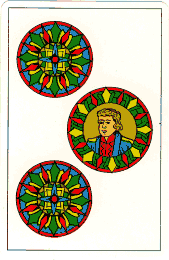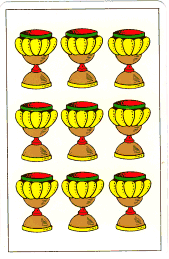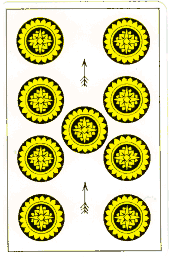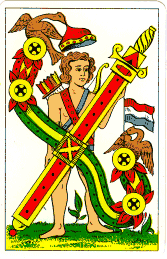Aluette

monsieur

madame

le borgne

la vache

grand-neuf

petit-neuf

deux de chêne

deux d'écrit

as
Introduction
Aluette is a four-player trick-taking game, but although the players play in teams of two, the partners do not combine their tricks. The object is to win more tricks than any other individual player, or in case of equality to be the first to have won them; the team of the player who achieves this wins the point. Thierry Depaulis has provided the following historical introduction.
Aluette (or la Vache, "The Cow Game") is played in Vendée and the coasts of Brittany, using a 48 card Spanish suited pack with special designs. Aluette is a very peculiar trick-taking game where suits are irrelevant. Partners can use gestures to signal what cards they hold. The play mechanism is similar to that of early games like Truc / Trut and Put, and it cannot be a coincidence that 3's, 2's and aces are high cards in all these games. The use of Spanish suited cards is surprising, but there is a theory that these suits were originally used throughout France and were displaced in most of the country by French suits when those were invented in the 15th century. Aluette may be an extremely old game: some late 15th-century records from the South-West of France mention a card game called Luettes. However, it is clear that Nantes is the modern cradle of the game, and until about 1700 there was in Nantes a large group of Spanish merchants, and Spanish suited cards made in Thiers (Auvergne) were conveyed on the Loire river up to Nantes where they were shipped to Bilbao and Navarra. Therefore a late introduction, perhaps in the 17th century, through Spanish merchants in Nantes is also possible.
Players and Cards
There are four players in two fixed partnerships, partners sitting opposite each other. Deal and play are clockwise.
The 48-card pack consists of king (roi), knight (cavalière), jack (valet), 9, 8, 7, 6, 5, 4, 3, 2, ace (as) in each of the four suits coins, cups, batons and swords. Some of the important cards have pictures corresponding to their nicknames. The ranking from high to low is:
- Three of Coins (monsieur)
- Three of Cups (madame)
- Two of Coins (le borgne) - the blind man
- Two of Cups (la vache) - the cow
- Nine of Cups (grand-neuf)
- Nine of Coins (petit-neuf)
- Two of Batons (deux de chêne) - two of oak
- Two of Swords (deux d'écrit) - two of writing
- The four Aces
- The four Kings
- The four Cavalières
- The four Jacks
- The Nines of Swords and Batons
- The four Eights
- The four Sevens
- The four Sixes
- The four Fives
- The four Fours
- The Threes of Swords and Batons
Note that apart from the highest eight cards, the cards come in groups of two or four of equal rank.
In North America, the special cards used for Aluette can be obtained from TaroBear's Lair.
Deal and Chant
To choose the teams and the first dealer, any player deals the cards one at a time face up to the players until the highest four cards have appeared. A player who has received one of these cards is dealt no further cards. The players who receive "monsieur" and "madame" are partners against the players who receive "le borgne" and "la vache". "Madame" is the first to deal, and thereafter the turn to deal passes to the left after each hand.
The dealer shuffles and the player to dealer's right cuts. Then the dealer deals nine cards to each player in batches of three, and checks that there are twelve cards left over.
If all four players agree, the twelve remaining cards are dealt one at a time alternately to the player to dealer's left and the dealer, so that each has six extra cards. These two players then each select six cards to discard face down, to reduce their hands to nine cards - naturally they will each discard the lowest six cards in their hands. This process is known as chanter (singing). If any player objects, there is no singing: all players play with the nine cards they were originally dealt, and the last twelve cards remain unused and unseen until the end of the play.
Play
The player to dealer's left leads to the first trick, and the other players in turn each play a card. There is no restriction on which cards can be played. Whoever played the highest card wins the trick, stacks it face down in front of him or her, and leads any card to the next trick. This continues until all nine tricks have been played.
Since some of the cards are equal in rank, it quite often happens that there is a tie for highest card played to the trick. In this case the trick is "spoiled" (pourri) and no one wins it. The player who led to the spoiled trick leads again to the next trick.
With a little experience, it becomes clear that there is a big advantage in playing last to a trick - one can wait and "voir venir" (see what comes). In most cases, at least for the first few tricks, the first two players should play low cards. The third player should play a high card to stop the fourth player winning the trick cheaply, and the fourth player will try to beat this card as economically as possible. Alternatively, the fourth player may throw a low card, sacrificing the trick but putting partner in last position for the following trick. It is often a good idea to for the fourth player to spoil the trick if possible by equalling the third player's card, thus keeping the advantage of playing last without giving the trick to an opponent. Of course players are free to depart from this pattern if the see a tactical advantage in doing so.
Scoring
When all nine tricks have been played, the team of the individual player who has taken most tricks wins 1 point. If, as often happens, two or more players tie for most tricks, the point goes to the first player who achieved that number of tricks. In order to remember who this was, it is customary for the first player who wins a seciond trick to turn one of its cards face up, and the first player who wins a third trick to turn two of its cards face up.
A game consists of five deals - so the player who dealt the first hand also deals the last - and the team that wins more points wins the match.
In order to make the game more interesting, many play that a player who wins by taking a series of consecutive tricks at the end, having previously won no tricks, scores two point rather than one for the team. This feat is called mordienne. If your partner is trying to make mordienne you can help by spoiling as many tricks as possible, trying to distribute tricks evenly between the opponents, and overtaking or spoiling any trick that your partner is in danger of winning during the first five tricks.
A team that considers that they have little or no chance of winning a deal can offer to surrender, to save time and to avoid the danger of mordienne. If the opponents accept the surrender, they score one point without play. If the opponents refuse the surrender they are committing themselves to win mordienne: if they succeed they score the usual 2 points; if they don't make mordienne the team that tried to surrender scores 2 points.
Examples: North and South are partners against East and West. The letters indicate who wins each trick, and 'X' is a spoiled trick.
- SENWSEXNW. South wins 1 point for North-South. When the high cards are evenly distributed, the tricks often tend to be won in rotation like this, each trick being won by the last player. By spoiling the 7th trick North engineered a situation where everyone has two tricks, but South wins by having been the first to achieve this.
- SENWENWNW. North wins 1 point for North-South by being the first individual player to get three tricks, even though the other team took more tricks in total.
- SXENXSWWW. West wins 2 points for East-West (mordienne).
- XSENXWSSS. This is just an ordinary 1-point win for N-S. It is not mordienne because South won the second trick as well as the last three.
- EXWEWNNNX. 1-point to North-South. This looks like a failed attempt at mordienne by North.
According to one account of the game (Guy Rebour: La Crapette et le Jeu de Aluette), much copied by other writers, mordienne can be announced before the lead to the first trick. Rebour states that if this happens the match is extended: it continues for as many deals as necessary until a team wins by achieving a score of at least 10 points. This is somewhat hard to understand. It is difficult to see why one would want to give away one's intention to play for mordienne by announcing it rather than playing it silently, and it is surprising that this should alter the winning condition for the match so dramatically. A match to 10 points would typically last about three times as long as a match of five deals. It may be that Rebour is in fact describing a separate variation here - one in which mordienne only scores if announced and the target is always 10 points.
Signals
Partners are allowed to communicate during the game by means of a fixed system of signals. Most of these are used to indicate that one holds a particular card. Signals can be used at any time during the play and even while picking up cards as they are being dealt. Naturally one tries to choose a time when one's partner is watching and one's opponents are not paying attention, and to make the signal as subtle as possible while getting the message across, to avoid detection by the enemy.
I strongly recommend anyone learning to play Aluette first to play several matches without any signals, in order to get used to the cards and the tactics of the game. Only then can one judge when it might be worthwhile to signal a particular card. Beginners tend to signal far too much. There is no point in signalling a card unless your partner actually needs the information. In particular if one member of a partnership has a strong hand, there is little point in signalling cards to the weaker partner - you just risk alerting the opponents to your strength. On the other hand it can be useful for the weaker partner to signal a good card that may complement the stronger player's holding.
| Card or message | Gesture |
| Monsieur (3 of coins) | Raise the eyes - look upwards |
| Madame (3 of cups) | Bend the head to one side or raise one corner of the mouth |
| Le borgne (2 of coins) | Close one eye - wink |
| La vache (2 of cups) | Mime a "moo" - pout |
| Grand-neuf (9 of cups) | Show the thumb |
| Petit-neuf (9 of coins) | Show the little finger |
| Deux de chêne (2 of batons) | Show the index and/or middle finger |
| Deux d'écrit (2 of swords) | Show the ring finger or mime writing |
| As (ace) | Open the mouth - for two aces open twice, etc. |
| I have a bad hand | Raise the shoulders |
| I will try for mordienne | Bite the lip |
Other Aluette web pages
Here is an archive copy of an Aluette page in French, with illustrations of some of the cards.